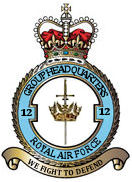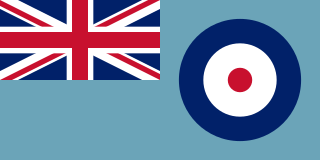
No. 12 Group RAF of the Royal Air Force was a group, a military formation, that existed over two separate periods, namely the end of the First World War when it had a training function and from just prior to the Second World War until the early 1960s when it was tasked with an air defence role.

No. 14 Group RAF was the title of several Royal Air Force groups, including a group responsible for anti-submarine activity from 1918 to 1919 after being transferred from the Royal Naval Air Service; a fighter group formed from a wing in the British Expeditionary Force in 1940; and finally a fighter group covering Scotland from 1940 to 1943.

No. 1 Group of the Royal Air Force is one of the two operations groups in RAF Air Command. Today, the group is referred to as the Air Combat Group, as it controls the RAF's combat fast-jet aircraft and has airfields in the UK, as well as RAF Support Unit Goose Bay at CFB Goose Bay in Canada. The group headquarters is located alongside Headquarters Air Command at RAF High Wycombe, Buckinghamshire. The other operational group is No. 2 Group RAF.

No. 3 Group RAF of the Royal Air Force was an RAF group first active in 1918, again between 1923 and 1926, then as part of RAF Bomber Command from 1936 to 1967, and recently part of RAF Strike Command from 2000 until it disbanded on 1 April 2006.

Royal Air Force Spitalgate or more simply RAF Spitalgate formerly known as RFC Grantham and RAF Grantham was a Royal Flying Corps and Royal Air Force station, located 2 mi (3.2 km) south east of the centre of Grantham, Lincolnshire, England fronting onto the main A52 road.

The Central Flying School (CFS) is the Royal Air Force's primary institution for the training of military flying instructors. Established in 1912 at the Upavon Aerodrome, it is the longest existing flying training school. The school was based at RAF Little Rissington from 1946 to 1976. Its motto is Imprimis Praecepta, Latin for "The Teaching is Everlasting".

Training Command was the Royal Air Force's command responsible for flying and ground training from 1936 to 1940 and again from 1968 to 1977. Training Command was formed from RAF Inland Area on 1 May 1936 and absorbed into RAF Support Command on 13 June 1977. From 27 May 1940 to 1 June 1968, Training Command did not exist as its functions were split into Flying Training Command and Technical Training Command.

Flying Training Command was an organization of the Royal Air Force; it controlled flight training units. The command's headquarters were at RAF Shinfield Park, Reading in Berkshire.

The Royal Air Force College (RAFC) is the Royal Air Force military academy which provides initial training to all RAF personnel who are preparing to become commissioned officers. The College also provides initial training to aircrew cadets and is responsible for all RAF recruiting along with officer and aircrew selection. Originally established as a naval aviation training centre during World War I, the College was established as the world's first air academy in 1919. During World War II, the College was closed and its facilities were used as a flying training school. Reopening after the War, the College absorbed the Royal Air Force Technical College in 1966.

Royal Air Force Harlaxton or more simply RAF Harlaxton is a former Royal Air Force station near the village of Harlaxton, 3 mi (4.8 km) south west of Grantham, Lincolnshire, England. The airfield was located in a triangle of flat fields midway between Harlaxton Manor and the nearby village of Stroxton.

No. 17 Group RAF was a group of the Royal Air Force which was operational in the last year of the First World War, and throughout the Second World War.

No. 3 Flying Training School is a Royal Air Force military training school, which manages elementary flying training for the Royal Navy and Royal Air Force and also for the training of all non-pilot aircrew for the RAF and is home to the Central Flying School Tutor Squadron.

No. 7 Flying Training School is a former Royal Air Force flying training school that operated between 1935 and 1994.
No. 8 Flying Training School is a former Royal Air Force flying training school that operated between 1936 and 1964.

No. 60 Group RAF was a group of the British Royal Air Force. It was established in 1940 with the headquarters in Leighton Buzzard, as part of RAF Fighter Command.

No. 23 Group RAF was a group of the Royal Air Force, first established in 1918. It disbanded the same year but reformed during 1926 and finally disbanded for the second time in 1975.

No. 25 Group RAF is a former Royal Air Force group. It was initially active between 1918 and 1919. It reformed during 1937, remaining active throughout the Second World War, disbanding again in 1948. It reformed a second time during 1951 and disbanded for a third time in 1968.

No. 24 Group RAF is a former Royal Air Force group. It formed in June 1918 from No. 46 and 48 Wings, disbanding in June 1919. The group reformed in July 1936 as No. 24 (Training) Group within RAF Training Command, and transferred to RAF Technical Training Command in May 1940, becoming No. 24 Group. It disbanded in December 1975.

No. 27 Group RAF is a former group of the Royal Air Force that was operational between August 1918 and May 1919 during the First World War, and between May 1941 and October 1958 during the Second and Cold War.

No. 29 Group RAF is a former Royal Air Force group that was formed as No. 29 (Training) Group RAF during October 1918 within the First World War at RAF Heliopolis controlling various units until November 1918. It was reformed on 27 November 1918 at No. 12 Great Stuart Street, Princes Street, Edinburgh controlling naval units as No. 29 (Operations) Group RAF until 31 March 1922 when it was disbanded into RAF Coastal Area. It was reformed as No. 29 Group within RAF Flying Training Command on 1 July 1942 at Buntingsdale Hall, Market Drayton controlling Air Gunners Schools and (Observers) Advanced Flying Units based in Northern England. It was disbanded on 7 January 1945.













